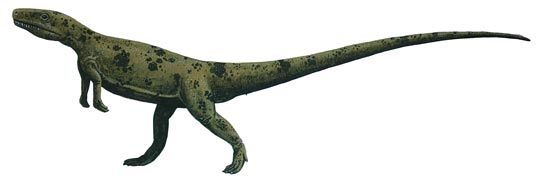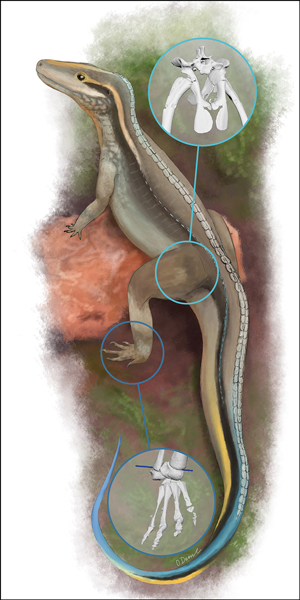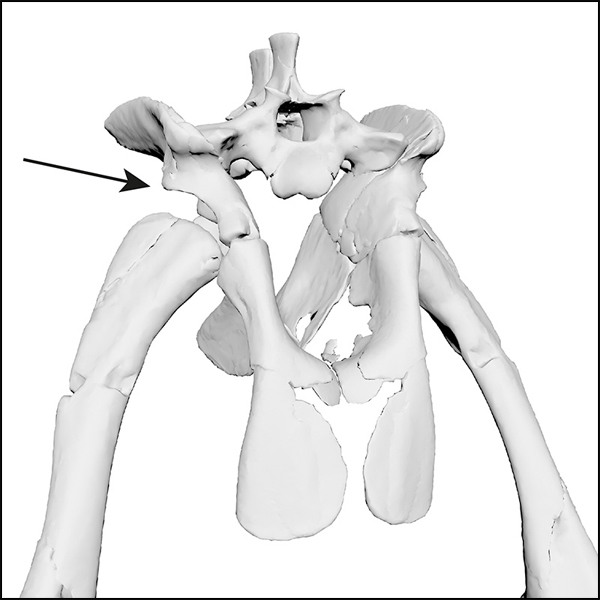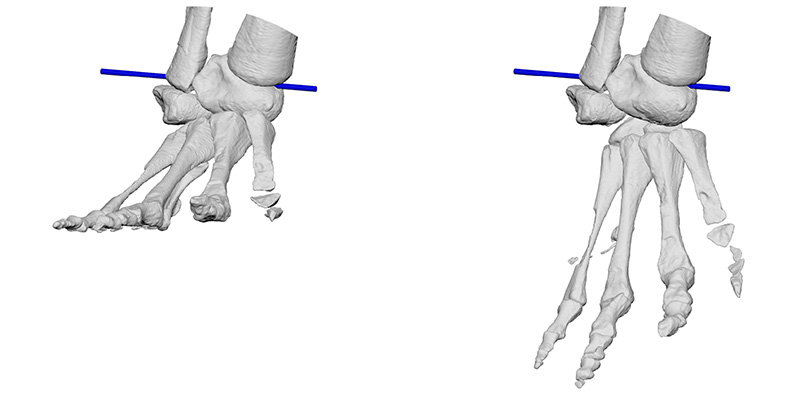Euparkeria Steps Out After New Research
Euparkeria Study Provides Important Step in Evolution of Archosaur Posture
Fossils of the stem-archosaur Euparkeria (pronounced Yoo-park-air-ree-ah), have been studied by scientists from the University of Bristol and the Royal Veterinary College in a bid to better understand the evolution of different gaits and locomotion within archosaurs. Three-dimensional modelling based on high resolution CT scans of the hindlimb of the small, agile Euparkeria (E. capensis), has revealed that it had a “mosaic” of functions associated with locomotion.
Euparkeria, which roamed southern Africa around 245 million years ago, is believed to be a close relative of the last common ancestor of both crocodilians and the dinosaur/bird branch of the Archosauria family tree, as such, a study of its fossil bones can provide important insights into the evolution of the archosaurs.
A Life Reconstruction of Euparkeria capensis

A Basal Archosauriform
This little reptile, that was formerly named and described in 1913, has recently been at the centre of another study which examined skull fossil material originally reported upon in 1965, but with the advance of scanning technology, scientists were able to provide much more information about the structure of Euparkeria’s skull: Little Euparkeria Steps into the Spotlight.
Euparkeria Provides Insight
Birds have an upright, erect bipedal posture, whilst extant crocodilians are quadrupedal and have a sprawling gait. The ancestor of the birds and crocodiles once shared a common mode of locomotion and Euparkeria can provide vital information helping scientists to work out how these differences came about.
Life Reconstruction of Euparkeria capensis

Picture credit: Oliver Demuth
Writing in the academic journal “Scientific Reports”, the researchers which included John Hutchinson, Professor of Evolutionary Biomechanics at the Royal Veterinary College, explained how they reconstructed the hip structure of Euparkeria based on CT scans. The complex and very detailed computer models these scans produced demonstrated that Euparkeria had a distinctive bony rim on the pelvis, called a supra-acetabular rim, covering the top of the hip joint.
This anatomical feature had only previously been found in later archosaurs on the crocodilian branch of the Archosauria. As a result, a more erect posture had been inferred for these extinct crocodiles. The supra-acetabular rim permitted the pelvis to cover the top of the femur (thigh bone) and support the body with the limbs in a more columnar arrangement – this type of joint is referred to as “pillar-erect”.
Identifying the Supra-acetabular Rim on the Hip Bone

Picture credit: Demuth et al (Scientific Reports)
Euparkeria is the oldest known reptile that possessed such a joint, this raises the intriguing question as to whether it had a more erect dinosaur/bird-like posture rather than the more sprawling posture as seen in modern crocodilians.
Testing How the Hindlimbs Could Move
Computer simulations were created to test the range of movement in the hindlimbs. The team estimated how far the femur could have rotated until it collided with the hip bones. The computer models also examined how the ankle joint functioned as well.
The simulations suggested that while the femur could have been held in an erect posture, the foot could not have been placed steadily on the ground due to the way the foot rotates around the ankle joint, implying a more sprawling posture. However, the supra-acetabular rim covering the hip joint restricted the movement of the thigh bone in a way that is not seen in any living tetrapod with a sprawling gait, this indicates that Euparkeria had a more upright posture.
Examining Three-dimensional Models of the Euparkeria Ankle to Assess Function

Picture credit: Demuth et al (Scientific Reports)
The researchers conclude that Euparkeria possessed a “mosaic” of locomotor functions. It is the earliest reptile known with this peculiar hip anatomy and an ankle joint allowing a more erect posture did evolve in later Triassic archosaurs.
Professor Hutchinson stated:
“The mosaic of structures present in Euparkeria, then, can be seen as a central stepping-stone in the evolution of locomotion in archosaurs.”
The scientific paper: “3D hindlimb joint mobility of the stem-archosaur Euparkeria capensis with implications for the postural evolution within the Archosauria” by Oliver E. Demuth, Emily J. Rayfield and John R. Hutchinson published in Scientific Reports.
The Everything Dinosaur website: Everything Dinosaur.

